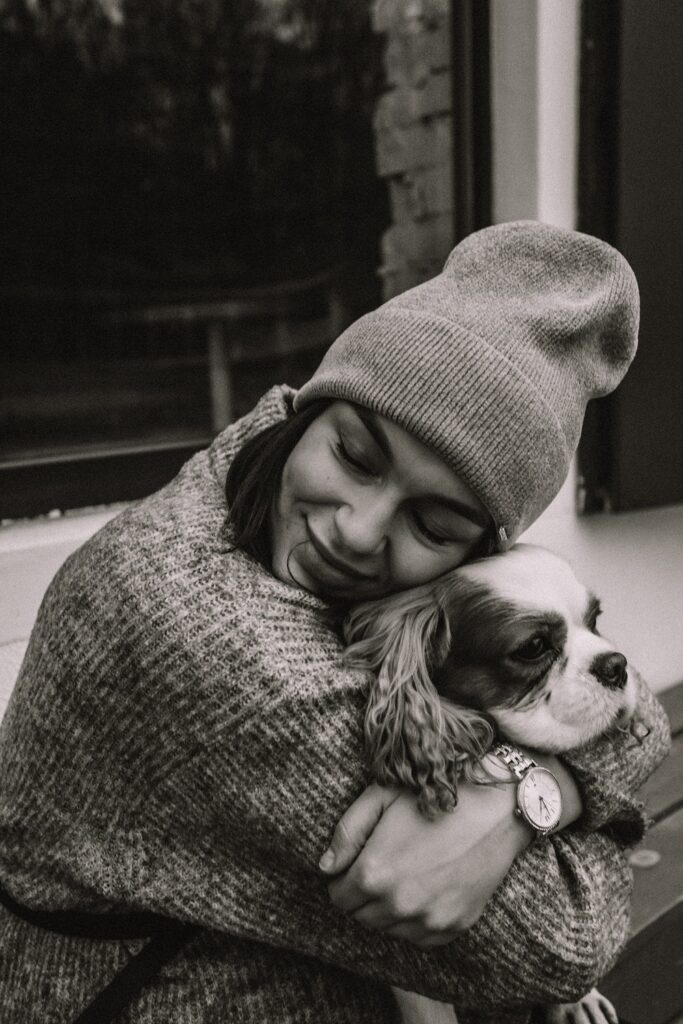Common things that humans do that annoy dogs include:
- Hugs
- Inconsistent commands and/or schedules
- Interrupted sleep
- Yelling
- Teasing
- Leaving them alone for too long
Dogs are more likely to put up with these annoyances from their human, but there are often more effective ways to communicate and interact with your dog. Keep reading to learn why these vex your canine friend and what you can do instead.
Hugs
While some dogs soak up every ounce of physical interaction they can get, hugs do not mean the same thing in dog language as they do to humans.
When dogs are wrapping arms around each other’s body it is usually a sign of dominance. Unlike primates, dogs have no history of grasping each other in this way to show affection.
Some companions love to get affection in this way from their humans, but it is a bad idea to hug a dog that is not familiar with you. Children are especially prone to this behavior, and it puts their faces too close for a quick nip to not connect.
Thorough petting can accomplish the same goal without putting your dog on edge.

Inconsistency
Dogs can learn about 165 words on average, but switching up commands is a quick and easy way to frustrate them. If you teach your dog to lay down completely with “down” one day but switch it up to “lay” the next, they are bound to get confused.
This is because dogs love consistency, and they do better when they know exactly how they should behave and what to expect.
This applies to the rules that you have in your house as well. Letting your dog on the couch one day and deciding against it the next is an easy way to create a rift in communication.
Make sure you decide what phrases and rules you intend to use, and then stick to those. If you do need to change things down the line then make sure you reinforce that new rule and do not go back and forth.
Interrupted Sleep
No one likes to be interrupted when they sleep, but dogs aren’t exactly capable of tossing a pillow at you in protest.
This is especially true with older dogs that sleep more deeply and have impaired hearing, making it difficult to notice what is going on around them.
It is better to let your dog wake up naturally. Keep children from messing with them while they sleep, and resist the urge to wake them up just to see what they do.
If you do need to wake your dog up, try to do it as quietly and gently as possible. Avoid situations where you are shaking them awake abruptly as much as you can.

Yelling
Yelling almost always makes a bad situation worse. Dogs do not understand what they did wrong, but they do understand that you are angry.
This is an ineffective form of communication that is more likely to scare, confuse, or agitate your dog than it is to get your point across.
Focus on your tone when speaking to your dog, and try to keep a level head. It is better to take a step back and come back to a situation than it is to drive a wedge between the two of you.
Using a calm, deep tone is more likely to get their attention and let them stay calm enough to understand what is going on.
Teasing
Dogs are not likely to understand when you are teasing and playing with them, and it is perceived more as a provocation than anything.
This involves:
- Barking at them
- Pulling on them
- Holding something they want just out of reach
Teasing is more likely to contribute to anxiety or aggression, and it is better to avoid doing these things just for entertainment. Instead, play with your dog in ways that are enjoyable for both parties.
Too Much Alone Time
Dogs are social animals and leaving them alone in their crate, tethered, or in a pen for extended periods can lead to severe behavioral issues, such as:
- Separation anxiety
- Excessive barking/digging
- Destructive behavior
- Training regression
Try not to leave them alone for more than 10 hours at a time, and employ the help of friends, family, neighbors, or professional dog sitters as needed.







